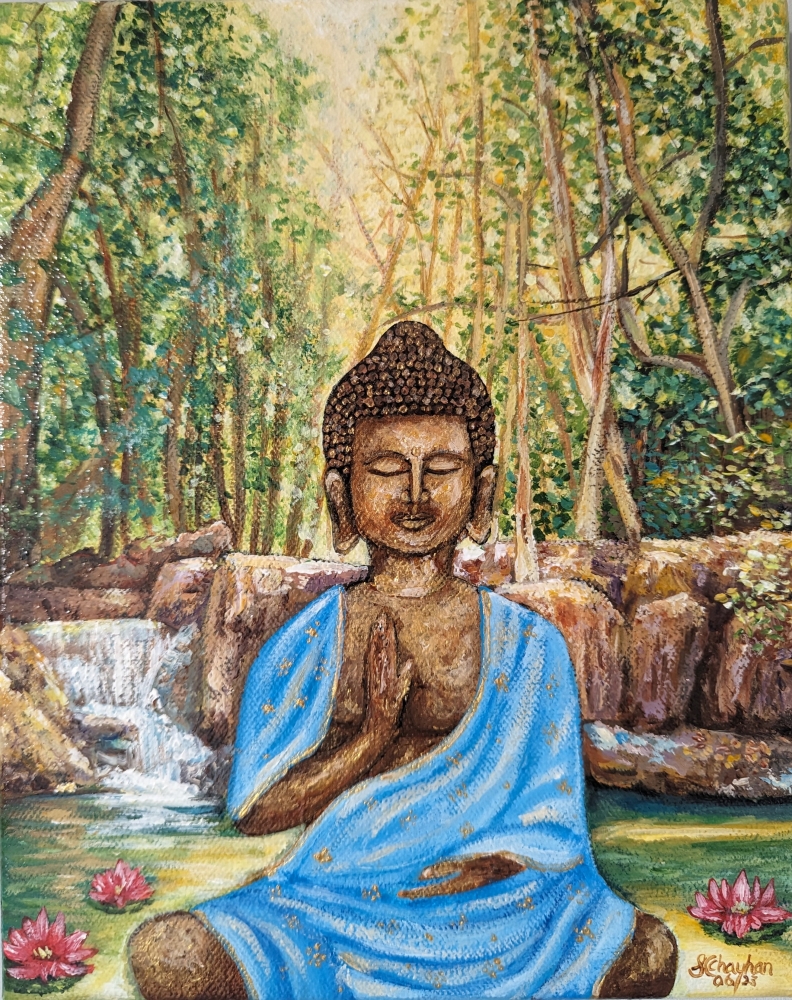The human figure in religious art: A symbolic journey through time
The human figure has been a central subject in religious art throughout history, serving as a powerful conduit for spiritual expression and divine storytelling. From the serene Buddha statues in Asia to the evocative Christian icons of Europe, the depiction of the human form transcends cultures and epochs, symbolizing the intricate relationship between humanity and the divine.
 Lord Buddha. Sharina Chauhan (Sharina's Art)
Lord Buddha. Sharina Chauhan (Sharina's Art)
Ancient beginnings: The dawn of human symbolism
The use of human figures in religious art can be traced back to ancient civilizations. In ancient Egypt, pharaohs and deities were often depicted with human forms, emphasizing their divine nature and eternal power. The colossal statues of gods and kings, such as the iconic Sphinx and the statues of Ramses II, served not only as political propaganda but also as religious symbols of divinity and the afterlife.
In ancient Greece, the human form was idealized and celebrated in religious contexts. The gods and goddesses of Greek mythology were portrayed with perfect, often exaggerated human features, embodying ideals of beauty, strength, and virtue. The statue of Zeus at Olympia, one of the Seven Wonders of the Ancient World, exemplifies how the human figure was used to represent divine perfection and authority.
Christianity and the iconography of faith
Christianity brought a new dimension to the use of human figures in religious art. Early Christian art shunned elaborate depictions, focusing instead on simple symbols like the fish and the cross. However, as the religion spread and evolved, so did its artistic expressions.
The Byzantine era marked a significant development with the creation of religious icons. These sacred images of Christ, the Virgin Mary, and saints were not mere portraits; they were theological tools meant to convey the presence and essence of the divine. The figures were often rendered in a stylized manner, with elongated bodies and solemn expressions, set against gold backgrounds symbolizing heavenly realms. The purpose was not to replicate human appearance but to evoke spiritual contemplation and connection.
The Renaissance period witnessed a dramatic shift as human figures in religious art became more lifelike and dynamic. Artists like Michelangelo and Leonardo da Vinci infused their works with anatomical precision and emotional depth. Michelangelo's Sistine Chapel ceiling, with its powerful depiction of God creating Adam, captures a moment of divine interaction that underscores humanity's special place in the cosmos. Here, the human figure becomes a vessel for exploring complex theological themes, such as creation, sin, and redemption.
Eastern traditions: The sacred body in Hinduism and Buddhism
In Hindu and Buddhist art, the human figure is often depicted in a manner that conveys spiritual ideals and metaphysical truths. Hindu deities, like Vishnu and Shiva, are frequently shown with multiple arms and heads, symbolizing their supernatural abilities and omnipotence. These anthropomorphic representations serve as visual theology, illustrating the many facets of divine power and cosmic order.
Buddhist art, particularly in the form of statues of the Buddha, emphasizes serenity and enlightenment. The seated Buddha, with his calm demeanor and meditative posture, embodies the principles of inner peace and spiritual awakening. The human figure here is a representation of the potential for transcendence and the attainment of Nirvana, encouraging followers to aspire towards spiritual liberation.
Modern interpretations: Continuity and innovation
In contemporary religious art, the human figure continues to be a potent symbol, though often reinterpreted through modern lenses. Artists like Salvador Dalí and Marc Chagall have infused religious themes with surrealist and expressionist elements, creating works that challenge traditional perceptions while still engaging with core spiritual themes.
Dalí's "Christ of Saint John of the Cross," for instance, presents a striking, almost ethereal depiction of Christ on the cross, viewed from above. This perspective forces viewers to confront the crucifixion in a new way, emphasizing the cosmic significance of Christ's sacrifice. Chagall's colorful and whimsical depictions of biblical scenes blend Jewish folklore with Christian iconography, highlighting the shared spiritual heritage and human experiences across these traditions.
The eternal human form
The use of the human figure in religious art is a testament to its enduring power as a symbol of the divine-human connection. Whether idealized or abstracted, serene or dynamic, these representations continue to inspire, provoke, and facilitate a deeper understanding of the spiritual mysteries that define human existence. As long as humanity seeks to explore its place in the universe, the human figure will remain a central motif in the artistic quest for the divine.